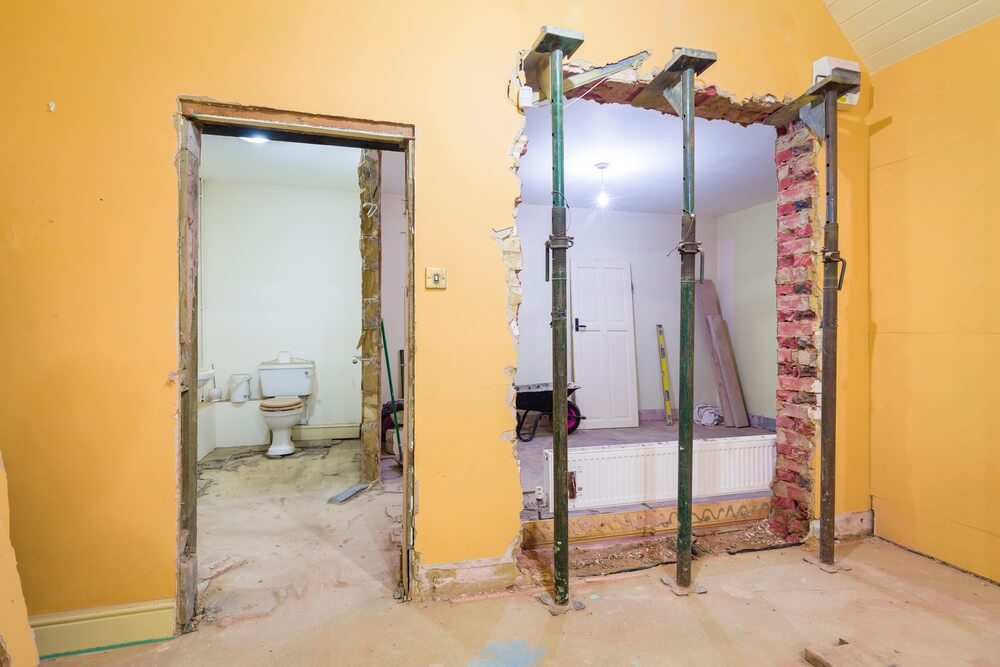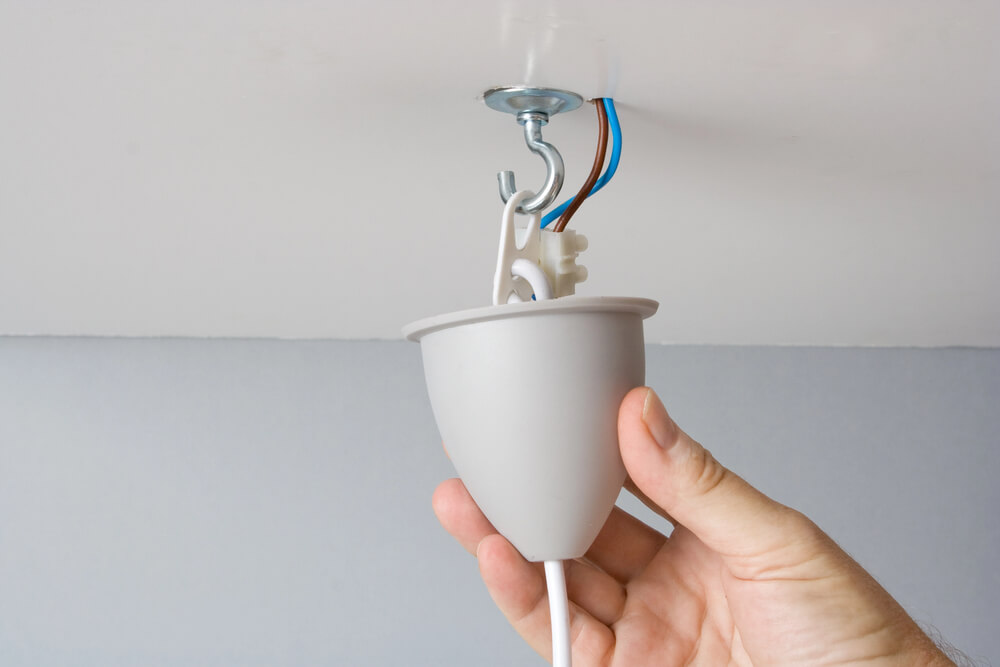There are many reasons to want a new look for the home. Maybe you recently bought a house with tons of space, but it’s missing several of your wishlist features. Maybe your kids have gone off to college, and it’s time to focus on your dreams for a change. Whatever’s behind your newfound excitement in transforming your home, the first step is deciding whether a renovation or a remodel is right for your project.
Aren’t Renovation and Remodeling the Same Thing?

Many builders and interior designers talk about remodeling and renovating as if they’re the same type of project, but these terms are very different. True, the end goal is the same — giving your home an exciting new look — but there are major differences in the steps and objectives along the way. When comparing renovation vs. remodel, factors like budget, room layout, structural concerns, home resale value, and your wishlist all come into play.
What Is a Renovation?
Renovations are makeovers, projects that update the look and feel of a space. Renovating is closely related to the concepts of refreshing and revitalizing, breathing new life into older rooms. For example, many kitchen renovations give the space a new color palette, get rid of old appliances, and refinish or replace the cabinets.
Renovations usually focus on decor and room accents:
-
Furniture
-
Paint and finish colors
-
Flooring materials
-
Light fixtures
-
Metal hardware
-
Design accessories
On occasion, a renovation can require minor repairs, like when you restore a worn-out hardwood floor and make it shine like new again. The same goes for outdoor projects like replacing an old roof or fixing weathered stucco.
Whole-home renovations are less common, but they do happen. This type of interior decorating project can involve completely transforming your home’s design style. In 2025, some homeowners are swapping out cold neutrals and minimalist furniture with warm browns and a country comfort vibe.
What Is a Remodel?

A remodel involves making major changes to the size, shape, purpose, or layout of a space. The dictionary definition of remodeling is to alter the structure of something. One of the most common remodeling projects for older homes is creating an open-concept layout where the kitchen, dining room, and living room share a space.
Remodeling almost always requires construction. Home remodels generally include deep structural changes:
-
Knocking out walls
-
Expanding available space
-
Creating new rooms
-
Repurposing spaces
-
Adding new features, like a fireplace or an in-ground pool
You can also remodel the outside of your home, building entirely new spaces like outdoor kitchens and pergolas. Covered patios, attached garages, and other indoor-outdoor expansions are all remodeling projects.
What Is an Example of Renovation Vs. Remodeling?
To help you understand the difference between remodels and renovations, it’s helpful to compare a few real-world examples.
Range Hood Installation: External Vs. Ductless
A stylish stove with a custom range hood can elevate any kitchen. Hand-hammered metal accents add vintage charm and create an eye-catching focal point for the space.
Unless you already have a compatible duct in place, installing a range hood with external venting requires remodeling. A contractor needs to create a suitable hole, running ductwork through the home’s outside wall or ceiling. This project isn’t overly complex, but it takes a professional to mount a jack and seal any roof penetrations correctly.
Or you can opt for a ductless range hood. State-of-the-art ductless hoods use recirculating filtration technology to avoid the need for ductwork. This type of installation is a simple renovation project. After mounting brackets on the wall or ceiling, you secure the range hood with basic tools and hardware.
Bathroom Makeover: Freestanding Tub Vs. New Shower Tile
Does your en-suite bathroom have an older shower that just doesn’t fit your style anymore? There are a few ways to give your bathroom a much-needed upgrade.
If you go the renovation route, one simple yet effective solution is to replace all of the tile in your shower and bathroom. Swapping out white ceramic with richly colored marble or granite can make the entire bathroom feel more elegant, especially if you add Paris-inspired lighting and a basin sink.
What if you’re secretly dreaming of a relaxation haven with a warm copper freestanding tub, hardwood floors, and recessed plants? This type of conversion requires a remodel. Not only do you probably need to change the location of plumbing, but you also have to make sure your floor joists are strong enough to handle the extra weight of luxury tub materials.
Renovation Vs. Remodel: How Do They Compare?

Renovation and home remodeling projects both have pros and cons. First, we’ll lay out the biggest differences. Then, we’ll help you decide which option fits your needs more closely.
Type of Transformation
Renovations don’t change the purpose of a room or its main features. Your kitchen stays a kitchen whether it’s chic or rustic. You might change the style of your light fixtures, but you’re not tearing into your walls or ceiling to replace your wiring.
A remodel goes deeper. Creating the master bedroom of your dreams may mean turning adjacent rooms into walk-in closets, knocking down walls to double your space, or even building an addition to the house.
Project Complexity
Renovations involve surface-level changes only. They update a room’s appearance and the decor inside it, but not the structure of the space.
On the other hand, remodeling projects often require navigating building codes and permits. Kitchen and bathroom remodels can require moving plumbing and running new electrical circuits. Home expansions require excavation for footings, water lines, and sometimes gas lines.
Design Limits
With good planning, a renovation can have a major impact on your home’s look and feel. That said, there are always hard limits.
For example, space-saving solutions like vertical storage and galley sinks can revitalize your kitchen, but there’s no way for renovations to add more floor space. What if your dream design absolutely requires a kitchen island? In this situation, a remodel would be your only option.
The beauty of remodeling projects is that they let you bring your design vision to life exactly how you want. From indoor water features and home mezzanines to terrace kitchens and spa bathrooms, virtually nothing is impossible.
Structural Needs
Aside from any repairs, renovations don’t usually require structural planning. Changing your dining room flooring, replacing the carpeting in your bedroom, or refinishing kitchen cabinets doesn’t affect the surrounding areas at all.
Even elements like windows and doors can be replaced if the new styles fit your existing frames (though you may need to get a permit depending on local building regulations). Replacing kitchen or bathroom fixtures (e.g., faucets and shower heads) is also within the scope of renovation projects as long as the configuration matches the current plumbing.
Remodeling is different. Any time you remove walls or make changes to your home’s frame, structural engineering is essential. Figuring out where the load-bearing walls are and how to achieve your project goals without sacrificing safety is like putting together a jigsaw puzzle. Weight is also a factor with upgrades like brick fireplaces and metal furniture.
DIY Vs. Professional Contractor
Renovation tasks are usually DIY-friendly. For design enthusiasts, painting and decorating rooms isn’t complicated. To replace many light fixtures, all you need is a screwdriver and someone to help you hold the new unit in place. Window and door replacements can be trickier, but experienced homeowners can often take them on.
Of course, there’s nothing wrong with hiring a professional for renovations. You save time and effort, reduce the risk of mistakes, and avoid the hassle of sanding, scraping, or prepping surfaces yourself.
For many remodeling projects, hiring a contractor isn’t optional. The builder has to create a plan that meets local codes, apply for permits, and install everything correctly. If plumbing changes or new electrical connections are involved, only a licensed plumber or electrician can handle the work.
Project Costs for Renovation Vs. Remodel
When you factor in labor, materials, and added complexity, the cost of remodeling projects is usually much higher than what you need for a renovation.
Buying a few gallons of paint costs about $100. Hiring painters only sets you back around $500 to $2,000 for your entire house. Installing a new kitchen sink costs $750 to $2,500 on average, depending on the style.
On the other hand, a bathroom remodeling project costs as much as $5,000 just to move plumbing. New showers range from $4,000 to $12,000. Building a complete en-suite bathroom can easily cost three or four times that amount.
Comparing kitchen renovation vs. remodel projects shows similar results:
-
Refinishing cabinets: $3,000 to $5,000
-
Replacing cabinets: $6,000 to $15,000
-
Refacing cabinets: $4,500 to $10,500
In comparison, a full kitchen remodel can cost $75,000 or more.
Your Long-Term Plans
When you remodel your home, the results are designed to last for ages. You can enjoy beautiful cabinets and countertops for decades. A high-end copper or brass bathtub can last a lifetime.
For good or bad, remodeling projects are also more permanent. Once you build an open-concept layout, there’s no practical way to return to a walled-off design — short of another major remodel. Fortunately, timeless elements like hardwood floors, leather furniture, and copper patinas are always in style.
What Are the Benefits of Home Remodeling Vs. Renovation Projects?

The purpose of renovation and remodeling is to align your home with your lifestyle. The right improvements can make your days more positive. Some save you time, and others help you sleep better.
And let’s face it — you choose some accents because they’re breathtaking and you want to leave your guests speechless. There’s nothing wrong with enjoying life’s luxuries.
What about advantages in terms of renovations vs. remodels? Is one approach superior? It depends on your goals.
Renovations Are Enticing To Buyers and Sellers
Making improvements to a home before putting it on the market is a smart investment, but not all changes have the same returns.
Renovations can make the property look brand new and spectacular without requiring too much capital. Happy buyers are more likely to go for your initial asking price.
Some types of remodeling can be worth it — kitchen remodels average an ROI of over 70% — but you have to be careful not to target too narrow a niche.
Remodels Deliver More Wishlist Items
Remodeling and customization go hand-in-hand. There’s nothing like a home where every wall and accent come together cohesively. Choosing Mediterranean-inspired rugs and furniture is one thing; building an open-air kitchen that makes you feel like you’re on Santorini is another level entirely.
As long as your budget allows for it, remodeling lets you make rooms larger, add luxury features, create picture-perfect views, and integrate indoor and outdoor spaces for maximum relaxation.
Renovation Projects Require Less Planning
Remodeling takes significant time and money — weeks or months for large-scale projects. Renovations have a more spur-of-the-moment feel. If you see a trend you like, all you need is a weekend or two to make it your own.
You Can Renovate Your Home More Frequently
If you’re the kind of person who likes to keep up with the latest trends — especially ones that push the envelope — renovation projects may be a better fit. Making minor changes lets you refresh the feel of your kitchen and bathroom every few years, keeping things interesting and unexpected.
Should You Renovate or Remodel?

Both renovating and remodeling have their place in high-end homes. Renovating is a better fit when you’re in the mood for short and sweet makeovers that pack a lot of style into a worry-free package. There are always exciting trends to get inspired by, from new color palettes to workstation sinks.
Home remodels are a bigger commitment, but they offer longer-lasting benefits. If your dream kitchen or bathroom requires moving plumbing, removing walls, or building a new structure, it’s time for remodeling. This type of project is what really puts your signature style on spaces and turns a house into your home.
Maximum Elegance for Renovation and Remodeling
Handcrafted design accents help you create unforgettable spaces. Antique copper, polished brass, and other fine metals add vintage flair and elegance. Discover luxurious additions for interior and exterior renovation and remodeling projects. Get a custom quote today.
